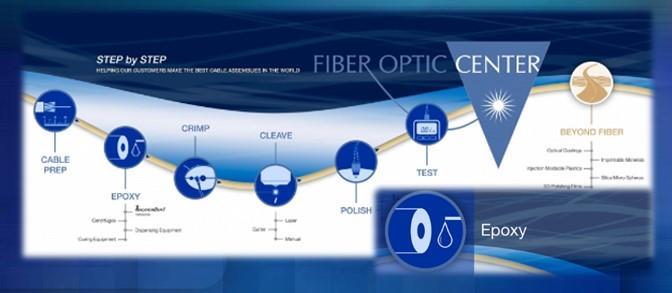For fiber optic cable assembly manufacturers, bi-packs of 2.5-gram and 4-gram are typical package sizes for epoxy. While these packages contain a very small amount of material, they support the fabrication of quite a few cable connectors and assemblies. (Note that epoxy package sizes range from 2-gram to 10-gram and higher.)
Which package size best suits your process? Given the many considerations, the choice is not as clear-cut as you may think. Often, customers ask me questions like this:
- “I use two 2-gram packages, but throw away most of the second package, because I don’t need it all. However, I’m reluctant to buy 4-gram packages, because I would still have waste. What do I do? Which package size is best for my process?”
- “We buy the 4-gram package to get a better price per gram. But there’s always some waste. Throwing away unused epoxy is like throwing away money. What do you suggest?”
- “Our process requires very little epoxy, and we use the smallest package size available. Even so, there’s still some waste. Why can’t we purchase packages with a smaller quantity?”
Recommendations to adjust your epoxy process, which can minimize material waste and reduce costs
Here are two ideas to alter your epoxy-related production process. These process adjustments may help you reduce epoxy waste, streamline your process and, ideally, fabricate a higher-quality product.
- Add another operator – As soon as your operator mixes Part A and Part B of the epoxy, he or she is essentially playing a game of Beat the Clock to use the material before its pot life expires. Therefore, it’s vital that the epoxy process be highly organized, swift, and efficient. One way to improve efficiency is to have two operators on your production line, simultaneously dispensing epoxy. Both operators would fill their syringes from one 4-gram package, which offers a lower price per gram. This approach could minimize waste, reduce your epoxy cost, and streamline your fabrication process.
- Freeze the unused epoxy for future use – Let’s say you purchase 2.5-gram packages of epoxy and typically use 1½ to 2 grams of each package. The remaining epoxy goes to waste. Here’s an idea: Purchase 4-gram packages (at a lower price per gram), mix and use the epoxy as you normally would, then freeze the remaining epoxy for later use.
Here are tips and considerations regarding freezing epoxy:
- After fabricating the connectors or cable assemblies, the remaining material in the syringe must be frozen right away. A certain amount of pot life will have been used, and freezing does not further impact pot life. For example, if your epoxy’s pot life is 24 hours and you mixed and worked with it for 4 hours, then the unused material has a pot life of 20 hours.
- Here’s an idea to extend the epoxy’s pot life and save money: Let’s say your process typically requires 2 grams of material. Purchase a 4-gram bi-pack, which offers a lower price per gram. Instruct your operator to place 2 grams of epoxy into the syringe. Then fill another syringe with the remaining epoxy from the 4-gram package and immediately freeze it. The frozen epoxy will have its full pot life.
- Freeze epoxy at -40 degrees C to stop the curing process.
- To freeze unused epoxy, place the tip on the syringe and put the plunger back. I recommend labeling the syringe with (1) remaining pot life and (2) expiration date.
- Consider implementing process controls, so operators have a clear understanding of all steps and labeling requirements.
- The recommended length of time to keep epoxy frozen is typically 6 months or less. When freezing epoxy, expect about 50% of the room-temperature shelf life. For example, if the material’s datasheet states a room-temperature shelf life of 12 months, when you freeze the epoxy plan to use it within 6 months.
- Thawing epoxy is fast and easy. Click here to read thawing instructions.
- Implementing this process adjustment – freezing unused epoxy – does require an initial investment of time and money. You’ll want to adjust your process, train your operators, buy additional syringes, and purchase a freezer if you don’t have access to one. (Fiber Optic Center can help you locate one.) While an up-front investment is required, you can realize cost savings over the long run – and you may discover a better process that results in better-quality products.
Answers to related epoxy questions:
“Why aren’t packages of less than 2.5 or 2 grams available?” – Some epoxy manufacturers offer 2.5-gram packages as their smallest quantity; one manufacturer offers a 2-gram package. When packaging the material, the manufacturers are mandated to supply a proper mix ratio of Part A and Part B while meeting tight tolerances. Offering bi-packs with less material is not practical, since that tiny quantity would make it extremely difficult to achieve the proper mix ratio while meeting tight tolerances.
“How precise are the packaging weights?” – The fiber optic world is driven by precision. If you purchase a 4-gram package, you can rely on getting 4 grams of epoxy. This is a data point to consider as you determine which package size best meets your process requirements.
“Would premixed, frozen epoxy work better for my process?” – Our customers who use premixed, frozen epoxy report two major benefits: (1) No need to worry about improper mixing due to operator error. Epoxy that is overmixed, undermixed, or has excessive bubbles can impact quality and disrupt the production process. (2) Using premixed, frozen epoxy helps to streamline the production process, since it’s in your freezer and ready to use, with no preparation other than a few minutes to thaw. Depending on your process and goals, using premixed, frozen epoxy can contribute to a streamlined process with higher-quality products.
“How do you safely dispose of epoxy?” – Once it cures and hardens, epoxy can be thrown away in regular waste. Think of it this way: You must allow a gallon of house paint to dry and harden before throwing it out. Liquid epoxy can be hazardous, because it contains materials that can leak into the ground, cause physical injury to sanitation workers, contaminate septic tanks, and harm the environment. Check your epoxy’s safety datasheet for specific disposal recommendations.
Conclusion: Which package size of epoxy is right for your process?
I often encourage my customers to consider purchasing 4-gram packages of epoxy – if this size supports their process. Briefly, here’s why I recommend the 4-gram package:
- Higher production quantities – Your facility can produce more connectors or cable assemblies per 4-gram package.
- Better value – In the 4-gram package, you get more material at a lower price per gram.
- Less material waste – There will always be a certain amount of material clinging to the epoxy package that cannot be squeezed out. If you can use one 4-gram package instead of two smaller packages, there will be less material waste, which contributes to cost savings.
- Less packaging wasted – Using one 4-gram package instead of two smaller packages means you are throwing away less plastic and other packaging materials. It’s always good to be kind to our environment!
Every production facility is unique, and your choices are determined by your facility’s goals and your individual process. Over the long run, any process adjustments you can implement – such as the ideas I’ve mentioned in this article – can help to reduce costs, streamline your process and, ideally, fabricate a higher-quality fiber optic cable assembly.
Additional resources from the FOC team include:
- View Epoxy Technical Solution Content
- View the Glossary, Acronyms, Military Specifications for Connectors
- Q&A Resource: email technical questions to AskFOC@focenter.com
- Bookmark the Adhesive/Epoxy Page and Contact Info




